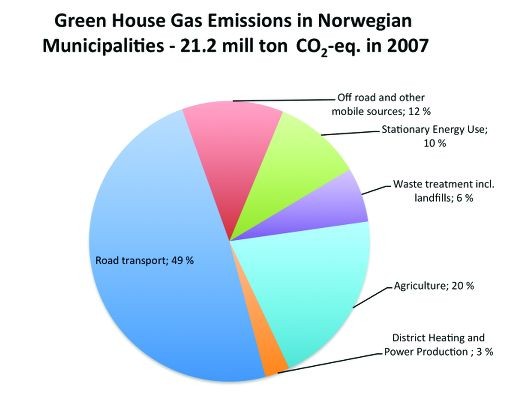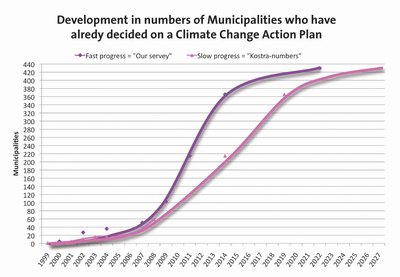Today emission levels relating specifically to local authorities amount to 21 million tons of CO2-eq. per year, which is approximately one half of the land-based emissions total produced in Norway.
Of these emissions 49% stem from road traffic and 60% from various kinds of mobile sources (tractors, off-road machines, etc). Emissions from agriculture amount to 20%, from stationary energy consumption 13%, and from waste treatment 6%. Emissions from industrial processing, the oil industry and air and sea transport are regarded as falling outside the local authority sector.
There are 430 municipalities in Norway. Some 40% of emissions related to local authorities come from municipalities with a population of more than 20 000 (11%), 37% from those with a population between 5 000 and 20 000 (34%) and 23% from those with a population of less than 5 000 (55%).
Individual municipalities can forward a number of reasons for not giving priority to cutting emission levels. From a global perspective the effect of each municipality on global warming is practically negligible. Moreover, the effects of each municipality's own efforts in this respect are also rather difficult to measure. Work on reducing emissions may often be in conflict with other local goals such as economic growth and increasing employment. In addition, financing emissions reductions often requires the transfer of resources away from other much needed purposes.
Despite this many municipalities in Norway are engaged in making a contribution to the creation of a good national climate policy. They are trying to the best of their abilities to transform national goals into their own local goals. The activity of municipalities in this field can to a large extent be explained by the existence of local idealists and of strong interests in national and local political party organisations. The municipalities' own organisation KS, has declared the climate question to be one of its main policy areas of interest in the coming years.
Increasing activity in the municipalities
There is already a considerable amount of activity ongoing in Norwegian municipalities in respect of emissions reduction. Three out of four municipalities have already published emissions reduction goals, made plans for reductions or at least decided to begin work on the subject. The largest and most populous municipalities are in the forefront here while the smallest lag somewhat behind.
A recently adopted National Planning Guideline under the Norwegian Planning and Building Act has now made the provision of municipal plans for emissions reductions compulsory. The Government expects all municipalities to have such plans politically adopted by July 2010.
In our opinion however the effect of this requirement on progress towards the drawing up and adoption of such plans remains uncertain in a situation where the work done up to now has been voluntary. Based on the progress made thus far we have outlined two different "prognoses" for progress; the fastest sees the requirement having an immediate effect while the slowest sees no effect over the baseline prognosis occurring.
In the faster prognosis 50% of the municipalities will have emissions reduction plans by 2011, the vast majority (85%) by 2014 and all municipalities by 2022. In the slower prognosis 50% will have emissions reduction plans by 2014, the vast majority by 2019 and all municipalities by 2027.
Aggregation of municipal climate goals to the national level
The targets and measures which the municipalities have launched, or have decided to launch, generally relate to stationary energy consumption; i.e. a shift away from oil based heating and the expansion of district heating, followed by goals and measures related to waste treatment and recycling. Far fewer municipalities have goals and measures related to agriculture; i.e. fertilizing plans, or related to land use and transportation; i.e. long-term measures to facilitate high density development around public transportation nodes.
Three alternative methods are discussed in terms of using individual municipalities' climate goals and measures to estimate an emission-cut-potential for the local authority sector as a whole. The calculation based on 51 different municipalities, with more or less precisely quantified targets, shows that the total potential emission cut is in the order of 6-7 million tons (a third of the total) of CO2-eq. per year compared to the trend situation for 2020.
The aggregation of local measures is however based on only a very small number of municipalities which have already specified measures and estimated their effects. The actual measures to be undertaken in various municipalities are quite similar. As such, it is possible to aggregate the emissions reduction potential at the national level with a reasonable level of accuracy. The calculation shows that the total potential emissions reduction is in the order of 2.4 million tons of CO2-eq. per year compared to the trend situation for 2020.
There is however a gap between goals and measures in these municipal climate reduction plans but the gap is not unreasonably large and may have an understandable explanation; i.e. that many of the goals assume the effects of national measures (taxation, etc) and technological development.
Stated local authority climate targets and measures
The results of our study reveal a significant variation in stated climate targets and in the formulation of climate goals and measures. The goals vary considerably; from specific quantified targets for reduction to more visionary goals for a carbon-neutral local community. In many cases however these goals should be seen as mere visions to strive for rather than programmes that can be implemented in practice. This implies that when formulating the goals and measures the municipalities still to a significant extent continue to lack basic knowledge on the subject.
The municipalities are capable of implementing various local tasks on emission cuts but they cannot be made solely responsible for this strategy. Greenhouse gas emission reduction is a state responsibility. The state, counties and municipalities must be viewed as one system. Within this system the municipalities must be met with both requirements and support. Idealism is not enough to attain results of the required magnitude.
In this light a proposal for a system where national authorities can buy emission reductions from local and regional authorities has recently been drawn up by Civitas on behalf of KS. The proposal is based on a broad review of existing and possible new measures. The system could be used as an alternative to purchasing climate quotas internationally. The municipalities receive economic incentives and the national authorities get access to significant domestic emission cuts for a predictable price.



Norwegian Emission Inventory and emissions in the municipalities
Total Norwegian emissions in 2008 amounted to 55 million tons CO2-eqv., according to the emissions inventory in line with the IPCC guidelines. Emissions from the municipal sector, approximately 21 million Tons CO2-eqv., are exclusive of emissions from offshore oil- and gas,aviation above 100metres,shipsmore than 800metres offshore and process industries.The source "stationary energy use" is mainly oil- and gas boilers used to heat buildings.This share is lowbecause a large amount of the electricity used in heating (approximately 80%of the demand),and 95-99%of Norwegian electricity production is hydropower-based with zero GHG emissions. (www.ssb.no)
This article is provided by:
Eivind Selvig, Master of Science
Rune Opheim, Chartered Engineer
Njål Arge, Civil engineer MSc
Rolv Lea, Cand oecon/Master of Economics, rolv.lea@civitas.no